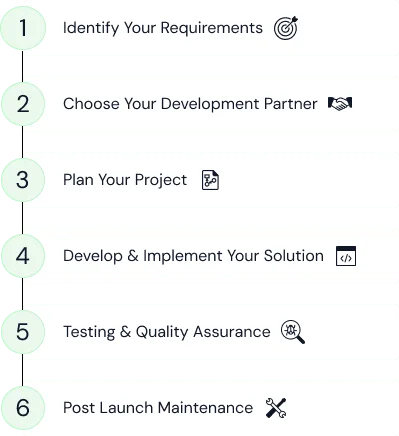Introduction
In today’s digital-first world, software isn’t just a support tool; it’s the foundation of how businesses operate, compete, and grow. Behind every seamless software application, scalable platform, or intuitive system lies a well-structured software development process.
Following a clear methodology ensures that projects stay on track, meet deadlines, and deliver tangible value to stakeholders and end-users. Whether you’re building new software, modernizing legacy applications, or adding new features to an existing software system, a disciplined approach matters.
In this article, we’ll explore the six essential phases of the Software Development Lifecycle (SDLC). Each phase breaks down into actionable steps and deliverables that help ensure success. Along the way, we’ll cover how different software development methodologies (Agile, Scrum, Waterfall, Spiral, Kanban, V-Model, and more) influence outcomes.
Why the Software Development Process Matters
Before diving into the phases, it’s worth asking: why does process matter so much in software engineering? Building software without a clear process is like starting a house construction without blueprints: you might get something that looks impressive on the outside, but it will take more time than it should, the structure will be unstable, costly to maintain, and risky to use. That’s why a well-defined software development process isn’t just a nice-to-have; it’s the foundation of every successful project.
The benefits of the software development lifecycle (SDLC) include:
- Risk management. Projects that follow methodologies like Agile software development, the waterfall model, or hybrid approaches are far better at catching problems early. Bugs, vulnerabilities, and usability gaps are addressed long before the software reaches the production environment. This not only saves money but also enhances trust with end users who rely on a stable and secure system.
- Software quality. By embedding testing and quality assurance throughout the development cycle, from unit testing to integration testing and usability validation, teams can deliver software that is not just functional but also reliable, scalable, and optimized for long-term performance.
- Adaptability. In today’s fast-moving digital economy, requirements rarely stay the same from start to finish. Markets evolve, new features become necessary, and feedback from end users reshapes the product vision. A process that incorporates iterative and incremental improvements enables quick adaptation without derailing the project.
- Stakeholder alignment. When everyone understands the steps, deliverables, and expected outcomes, projects move forward with fewer delays and less confusion, ensuring that user needs are reflected in the final software product.
In short, the software development process is the glue that holds a project together. It creates alignment, reduces risk, supports adaptability, and ultimately ensures that the end result is a high-quality software product that delivers real value to both the business and its users.

1. Identify your requirements
You've probably got a vision in mind for what your software solution will help you achieve, but what exactly do you need it to do? This is the first step in custom software development.
This is the requirement analysis and requirements gathering stage. Thoroughly and methodically work through your existing processes, needs, and gaps, and make a list of the features and requirements you need from a software solution. This will help you have productive conversations with potential development partners about everything from technical details to timelines and costs.
Every great project begins with clarity. Without understanding what’s needed, it’s impossible to deliver a high-quality solution.
Key activities include:
- Interviewing stakeholders and end users to understand user needs, desired functionality, performance, usability, scalability, and security
- Documenting software requirements, business goals, and constraints (budget, timeline, technical environment)
- Creating user stories, use cases, or requirement specifications, often with high-level prototypes or wireframes to validate the user interface, modules, and overall software architecture
- Deciding on project scope and priorities, including which features are "must-haves" vs. "nice-to-haves"
- Selecting an SDLC model: agile methodology, waterfall model, spiral model, or hybrid/iterative approaches that allow incremental releases
Deliverables: requirement spec / SRS (Software Requirements Specification), user stories, initial prototypes, cost estimates, risk assessment.
Why this phase matters: Skipping or rushing requirements leads to rework, wasted resources, and software that fails to meet end-user expectations.
2. Choose your product development partner
There are countless software vendors on the market today, so how do you decide which one is right for you? We go into more detail in our article about how to choose a custom software development company, but these are the highlights:
- Alignment with objectives. The right software developer understands your business objectives and has the technical expertise to back it up. They're eager to collaborate with you to truly solve your problems, not just to build you a shiny, trendy platform and collect their payment.
- Check methodologies. They have a ‘success mindset’, they can talk business as well as they can talk tech, and they have the processes in place to keep everyone on your team and theirs on the same page from beginning to end. Look for a partner who follows good software engineering practices and methodologies (e.g., Agile, Scrum, DevOps), uses automation for builds/deployment/testing.
- Evaluate expertise. Evaluate potential project management and development teams based on experience, especially in your type of software, domain knowledge, and past software development projects. Their ability to run sprints, handle prototyping, and manage incremental or iterative development cycles will determine how smoothly your project moves forward.
- Quality assurance practices. Ask potential partners about their testing phase practices. Do they emphasize unit testing, integration testing, and usability validation throughout the development cycle? How do they address risk management and identify vulnerabilities before the software reaches the production environment? A strong commitment to software quality and automation is a sign that your project will be delivered with fewer surprises.
- Communication and transparency. How do they handle stakeholder feedback? How transparent are they with workflow, progress, sprints, and standups? Your partner should function as an extension of your own development team, keeping stakeholders informed through clear reporting, defined deliverables, and collaborative tools. Whether it’s daily standups or regular milestone reviews in a sequential model, you need confidence that information flows smoothly across all team members.
We recommend you send RFP and interview several vendors, and don't be afraid to ask hard questions when you do. Review portfolio, ask for references, and validate software quality (can they show high-quality software, well-tested systems, and minimal vulnerabilities). The right partner can make a big difference in the success or failure of your software.
Deliverables: partnership agreement, development methodology plan, roles & responsibilities, contract / SLA.

3. Plan your project
Once you have chosen your vendor, the next step is the planning phase (also known as the system design phase). A thorough discovery process will allow stakeholders and your development team to sit down and work through every aspect of the project, from both a business and a technical standpoint.
At this stage, you'll refine your list of requirements, and your developer may even create some prototypes to model the functionality and user experience. Though we know you're excited to start building the project, don't skimp on the discovery phase. And don't let your vendor try to skimp on quality, either.
Elements of the planning phase include:
- Create detailed software design: architecture, module decomposition, data models, UI/UX design
- Define workflow: mapping out sprints (if using Scrum or agile), iteration cycles (incremental or iterative SDLC), or the sequential path in waterfall models
- Decide on prototypes: mockups, wireframes, MVP (minimum viable product) to get early validation from stakeholders/end users
- Estimate time for each development phase, assign team members, set milestones/deliverables, and plan resource allocation
- Plan for testing: what kinds (unit, integration, usability, security), when in the cycle they occur, who will perform them
In custom software development, the old adage of “prior preparation prevents poor performance” rings especially true!
Deliverables: architectural diagrams, mockups/prototypes, project plan with milestones/sprints, test plan.
4. Development and implementation of your solution
The next step is to develop the project using the selected programming language and technology stacks.
Often, development is carried out simultaneously with testing (step 5), which allows the vendor to analyze the work being done and implement corrections where needed before delivery. At this stage, it's essential that all stakeholders collaborate closely. The coordination among software engineers, quality assurance engineers, and design engineers has a direct impact on the overall quality of the project.
This is the heart of the development phase/implementation/writing code:
- Build software modules incrementally, often in sprints (if agile) or under a continuous development cycle
- Use clean, maintainable code; apply programming languages and technologies that match the architecture and requirements
- Incorporate automation in builds, code review, continuous integration / continuous deployment (CI/CD), and DevOps practices
- Regular reviews with stakeholders for feedback; adjust where needed (“iterative development”)
Once development is complete (along with testing and quality assurance), it's time to deploy the software. This often happens in three stages: initial data upload, progressive feedback gathering, and full rollout.
The reasoning behind this step-by-step deployment approach is that launch generally runs alongside additional bug fixes, and it's better for everyone if the testers can gradually detect and fix any possible issues before the software is fully launched.
Deliverables: working increments (features), codebase, integration of modules, internal documentation.

5. Testing and quality assurance
Quality assurance (QA), or the testing and debugging process, is just as important as development. Conducting testing simultaneously with coding allows the QA team to find and fix bugs before they're so deeply embedded in the project that fixing them requires undoing (and then redoing) days, weeks, or even months of work. Focus is on software testing, validation, and quality assurance to ensure the product is ready for production:
- Conduct unit testing, integration testing, UI/UX testing, performance testing, security testing, etc.
- Use test automation where possible to streamline regression testing and catch vulnerabilities early.
- Involve end users or stakeholders in acceptance testing to ensure usability and functionality match expectations.
- Fix bugs, refine features, polish user interface and software design, ensure scalability and performance.
QA should comprise at least 30 percent of the total time allocated for the project, and it's most effective when completed by a separate team, which allows for more objectivity and efficiency.
Deliverables: test reports, bug fixes, refined versions of software, and final approval from stakeholders.
6. Post-launch maintenance
Deployment shouldn't be the end of your relationship with your custom software vendor. Rather, they should be available in some capacity to support any post-launch needs, from bug fixes to new features that may crop up as the product is used in real-life scenarios.
Post-launch maintenance includes:
- Monitor performance, error rates, user feedback, and usage metrics to find areas to improve or optimize
- Release updates: new features, enhancements, patches (security, bug fixes), improvements in usability or scalability
- Ensure compatibility with evolving systems, platforms, or modules; adapt architecture when required
- Maintain documentation, support end users, and continuous improvement (sometimes via agile or DevOps strategies)
Deliverables: maintenance roadmap, version updates, support processes, monitoring and metrics, ongoing user feedback loops.

Choosing the Right Software Development Methodology
Throughout these phases, we choose or adapt a methodology that best fits your project:
- Waterfall model: sequential, best for well-defined projects where requirements are unlikely to change
- Agile methodology (Scrum, Kanban, iterative): more adaptable, supports incremental or iterative software development, allows early delivery of core features, and frequent stakeholder feedback
- Spiral model: risk-driven, good when you want repeated prototyping, risk assessment, and incremental refinement
By combining methodologies (hybrid models), incorporating DevOps, and embedding automation and feedback loops, we can deliver better user experience, reduce development cycle risks, and adapt to change.
Tips for Ensuring Success in Software Development Projects
In addition to following the six phases, these practices enhance outcomes:
- Engage all stakeholders early and continuously
- Use prototypes and MVPs to validate design early and reduce rework
- Maintain transparent communication and clear deliverables at each stage
- Automate wherever possible: builds, testing, deployment
- Prioritize software quality, security, scalability, and user experience
- Plan for adaptability: accommodate new features, evolving user requirements
Final Thoughts: Turning Process Into Value
A well-defined software development process (or software development lifecycle) is key to delivering high-quality software that meets both business and user needs. By following the six phases — identifying requirements, choosing the right development partner, planning, developing & implementing, rigorous testing, post-launch maintenance — and choosing a methodology (hybrid, waterfall, or agile model) that suits your project, you can build software that’s reliable, scalable, and flexible.



